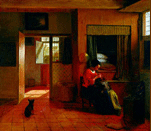










26.
Commemorative Labors: Women
and the Construction of Monuments
Organizers:
In this workshop, we will use the tools provided by the disciplines of English and Art History to examine early modern women’s construction of monuments. By discussing both images and literary texts and by investigating women’s role in building physical monuments together with their role in constructing textual legacies, we will encourage an interdisciplinary approach to women’s commemorative labors.
At the beginning of the session, we will spend no more than 15 minutes on introductions. Participants will be invited to identify themselves and their interests as they relate to the workshop, and each of the three organizers will introduce herself and provide questions for discussion that relate to the materials in which she specializes: Michelle will introduce the Grymeston text and some of the Clifford material, Susan will provide questions about the Clifford and Lefebvre texts, and Sara will raise questions about the Friedman and Durant pieces.
The three organizers will then serve as discussion facilitators for the remainder of the session; each organizer will be prepared in advance with additional discussion questions that she can ask as needed throughout the workshop, and participants will be encouraged to bring their own questions and ideas to the discussion. The readings that we have selected, which include images in addition to diary entries, a mother’s legacy book, and critical theory, will be circulated in advance together with a list of potential topics or questions for discussion. These materials provide multiple definitions of and contexts for “monuments” in the period, and we encourage participants to think in broad terms about commemorative artifacts and to bring their own disciplinary interests to bear on these categories. The readings will allow for a productive interchange about the nature of monumental structures, their social and theoretical importance, and the forms of female agency that they facilitate or make visible. We will discuss the specific nature of these documents, but we will also urge participants to converse more generally about the issues of religion, class, and familial relationships that these readings foreground.
This workshop will allow participants to think in new ways
about the relationships between women and monuments and will allow them to
explore the various forms that these monuments could take in the early modern
period. Acts of commemoration may seem segregated from other social spaces
but they emerge from and interact with the networks of economy, religion,
politics, rituals, and artistic representations that construct and/or overlay
physical, symbolic, and mental spaces. The labor of loss and bereavement supported
and made visible the connections among individuals, families, and society.
It also allowed women a sanctioned, albeit limited outlet for creativity and
agency. This workshop will investigate the ways in which religion, class and
textual or artistic genres influence women’s commemorative labors. It
will also consider women’s role as workers both in the physical sense
as builders and laborers and in the less tangible sense as those who ensured
the social reproduction of cultural, familial, and historical values and artifacts.
This workshop will ultimately encourage participants to make historical, literary,
and theoretical sense of early modern “monuments” (in their various
forms), and it will lead to a greater understanding of the multiple ways in
which women could commemorate their own lives or those of their families.
Preliminary List of Readings and Images:
French, Sara. Women, Space & Power. 144-151.
Lamb, Mary Ellen. “The Agency of the Split Subject: Lady Anne Clifford and the Uses of Reading.” ELR 22.3 (1992): 347-368.
Thrift, Nigel. Spatial Formations. London: Sage Publications, 1996. (Excerpts: 1-50, esp. 6-17).
|
|
|
||||||
|
|
 |
 |
|
||||
 |
|
 |
|
||||
|
|
|
||||||
|
|
|
||||||
 |
|
||||||
|
|
|
||||||
| |
|
||||||
 |
|
||||||
 |
|
||||||
 |
|
||||||
 |
|
||||||
|
|
|
||||||
|
|
 |
|
|
||||
 |
|
||||||
|
|
|
|
|
|
|
|
|